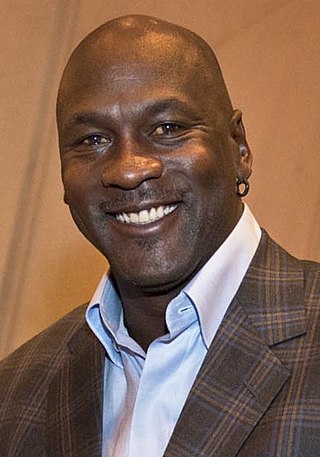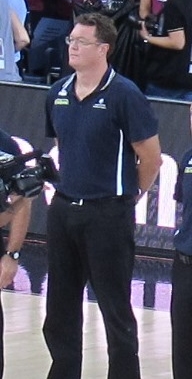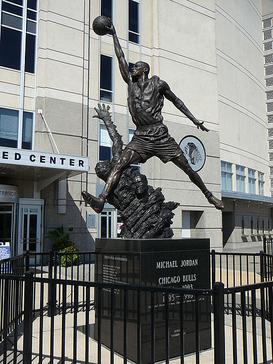Menu and attractions
Michael Jordan's Restaurant billed itself as "sporty and casual", [1] with an American menu. Dishes included steak, sole, pasta, hamburgers, ribs, chicken, pork chops, and salads, along with "Juanita's Macaroni and Cheese", which was based on a recipe from Jordan's wife. [2] [3]
The restaurant was housed in a three-story red brick building, [3] which had formerly served as part of a cable car powerhouse. [4] The building was adorned with a 25-foot (7.6 m) high cutout basketball on its roof and a 30-by-30-foot (9.1 by 9.1 m) banner of Michael Jordan. The first floor comprised a 150-person capacity sports bar, a 6-by-20-foot (1.8 by 6.1 m) video wall, and a gift shop that sold a large variety of Jordan merchandise, including licensed apparel and collectibles custom made for the restaurant by companies such as Nike and Wilson Sporting Goods. It also contained a large collection of Michael Jordan memorabilia, such as jerseys, trophies, shoes, photographs, Sports Illustrated magazine covers, and children's drawings of the basketball star. The 200-seat main dining room, which featured a portrait of Jordan by Chicago artist Ed Paschke, was on the second floor. The Jordan family had their own private room on the second floor, and the restaurant staff said that Jordan visited as often as three times a week. The third floor of the building was a meeting and banquet hall. [3] [5] The design firm Zakaspace worked on the restaurant. [6]
Michael Jordan's received mixed reviews from critics. Eleanor Lee Yates of the Fayetteville Observer said the restaurant was "a pleasant surprise", [2] while Sandra Kallio of the Wisconsin State Journal praised it for "excellent food, superb staff and relaxing atmosphere". [7] However, the Chicago Tribune 's Phil Vettel described the restaurant as "mediocre". [8]
History
Michael Jordan's Restaurant was the brainchild of Joe and Gene Silverberg, owners of the Bigsby & Kruthers clothing store. They obtained the rights to use Jordan's name in 1990 and spent $6 million developing the restaurant. [3] Jordan himself never had ownership stakes in the restaurant, though he provided input in terms of the decor and the menu. [9] He said he wanted it to be the "kind of place where I can bring my family and friends to eat". [10]
The restaurant opened on April 28, 1993, in the former location of Burhop's Seafood on LaSalle Street in Chicago. Guests at the grand opening included Illinois governor Jim Edgar, Chicago mayor Richard M. Daley, actor Mickey Rooney, and comedian Jackie Mason. [11] During the first few months of operation, the restaurant received up to 1,500 visitors and 7,000 telephone calls each day. Many waited several hours to get a table, since the restaurant did not take dinner reservations. [5] [12] Michael Jordan's remained a popular tourist attraction throughout the 1990s and became a major gathering spot for Chicago Bulls fans during the team's championship runs. [13]
Gene Silverberg said he and his brother began feuding with Jordan in 1996, when Jordan reportedly attempted to change the restaurant from a family-oriented business to a more upscale establishment. In 1997, Jordan opened his own Chicago restaurant, the more formal One Sixtyblue, and generally stopped appearing at the other except for charity events. Jordan's namesake restaurant continued to draw crowds despite his absence, but after Jordan's second retirement in January 1999, the Silverbergs announced that they would remodel the site as Sammy Sosa's Restaurant, a family attraction named after the Chicago Cubs baseball player. They planned to reopen Michael Jordan's Restaurant in a smaller building. [14] In October 1999, Jordan asked a federal judge to terminate his contract with the Silverbergs, explaining that he had not received adequate information about the proposed move. Jordan was also angry that the Silverbergs told the press he was not appearing at their restaurant on a regular basis. He argued that he was never obligated to do so, and that the Silverbergs tarnished his image. [15] The Silverbergs closed the restaurant for good in December 1999, [9] and in June 2000 Jordan won exclusive rights to use his name for restaurants in Chicago. [16] Sammy Sosa's Restaurant never materialized, in part because Sosa did not want to "step on Michael's toes". [17]
Memorabilia from Michael Jordan's Restaurant was auctioned in mid-June 2000. Twenty-six items had once belonged to the Silverbergs' private collection. [18]

Michael Jeffrey Jordan, also known by his initials MJ, is an American businessman and former professional basketball player. He played fifteen seasons in the National Basketball Association (NBA) between 1984 and 2003, winning six NBA championships with the Chicago Bulls. He was integral in popularizing basketball and the NBA around the world in the 1980s and 1990s, becoming a global cultural icon. His profile on the NBA website states that he "By acclamation, Michael Jordan is the greatest basketball player of all time." The NBA Most Valuable Player Award trophy is named the Michael Jordan Trophy.

Lucien James Longley is an Australian professional basketball coach and former player. He was the first Australian to play in the National Basketball Association (NBA), where he played for four teams over 10 seasons. Longley most notably played for the Chicago Bulls, with whom he won three championships from 1996 to 1998. He represented Australia as a player at three Olympic Games in 1988, 1992 and 2000, and has worked as an assistant coach for the Australian national basketball team.

Scotty Maurice Pippen Sr., usually spelled Scottie Pippen, is an American former professional basketball player. He played 17 seasons in the National Basketball Association (NBA), winning six NBA championships with the Chicago Bulls. Considered one of the greatest small forwards of all time, Pippen played an important role in transforming the Bulls into a championship team and popularizing the NBA around the world during the 1990s.

United Center is an indoor arena on the Near West Side of Chicago, Illinois, United States. It is home to the Chicago Bulls of the National Basketball Association (NBA) and the Chicago Blackhawks of the National Hockey League (NHL). It is named after its corporate sponsor United Airlines, which has been based in Chicago since 2007 and has a hub at O'Hare International Airport. With a capacity of nearly 21,000, the United Center is the largest arena by capacity in the NBA, and second largest arena by capacity in the NHL. It also has a seating capacity of 23,500 for concerts.
Jerome Richard Krause was an American sports scout and executive who was the general manager of the Chicago Bulls in the National Basketball Association (NBA) from 1985 to 2003.

Craig Anthony Hodges is an American former professional basketball player and former head coach of the Westchester Knicks of the NBA Development League. He played in the NBA for 10 seasons and led the league in 3-point shooting percentage three times. He won two NBA championships with the Chicago Bulls and, along with Larry Bird, is one of only two players to win three consecutive Three Point Contests at the National Basketball Association All-Star Weekend, winning the competition in 1990, 1991, and 1992. Hodges also holds the Three Point Contest records for the most consecutive shots made with 19, set in 1991, and the most points scored in a single round at 25, set in 1986. He was later a head coach at Chicago State University, an assistant coach for the Los Angeles Lakers and head coach of the Halifax Rainmen of the National Basketball League of Canada.

The Bulls–Knicks rivalry is a rivalry between the Chicago Bulls and the New York Knicks of the National Basketball Association (NBA). The two basketball teams have played each other every year since the Bulls first joined the NBA in 1966.
John William Bach was an American professional basketball player and coach. A forward/guard, Bach played college basketball at Fordham University and Brown University. He was selected by the Boston Celtics in the 1948 Basketball Association of America (BAA) Draft, and played 34 games for the Celtics.
The 1995–96 NBA season was the Bulls' 30th season in the National Basketball Association. During the off-season, the Bulls acquired controversial All-Star forward and rebound specialist Dennis Rodman from the San Antonio Spurs, and signed free agents Randy Brown and James Edwards. At midseason, the team signed John Salley, who was previously released by the expansion Toronto Raptors; Rodman, Edwards and Salley were all teammates on the Detroit Pistons during the "Bad Boy" era, where they won two straight championships in 1989 and 1990. The Bulls had the best team offensive rating and the best team defensive rating in the NBA.
The 1996–97 NBA season was the Bulls' 31st season in the National Basketball Association. The Bulls entered the season as defending NBA champions, having defeated the Seattle SuperSonics in the 1996 NBA Finals in six games, winning their fourth NBA championship. During the off-season, the Bulls signed 43-year old free agent All-Star center Robert Parish, who won three championships with the Boston Celtics in the 1980s. Coming off of one of the greatest seasons in NBA history, the Bulls, on the backs of recording another first-place finish in their division and conference, repeated as NBA champions. The Bulls were led by Michael Jordan, perennial All-Star small forward Scottie Pippen, and rebound ace Dennis Rodman, with the former two both being selected for the 1997 NBA All-Star Game, in which Jordan recorded the first triple-double in an All-Star Game. It was also Pippen's seventh and final All-Star appearance. Other notable players on the club's roster that year were clutch-specialist Croatian Toni Kukoč, and sharp-shooting point guard Steve Kerr.
The 1997–98 NBA season was the Bulls' 32nd season in the National Basketball Association. The Bulls entered the season as the two-time defending NBA champions, and in the Finals, they met the Utah Jazz in a rematch from the prior year's NBA Finals and just like that year, they would go on to defeat the Jazz in six games to win their sixth championship in eight years and complete the franchise's second "3-peat".
The 1990–91 NBA season was the Bulls' 25th season in the National Basketball Association. During the off-season, the Bulls acquired Dennis Hopson from the New Jersey Nets, and signed free agent Cliff Levingston. The Bulls overcame a slow start, losing their first three games of the season, as they later on went on an 11-game winning streak between February and March, held a 32–14 record at the All-Star break, then posted a nine-game winning streak also in March. The Bulls finished in first place in the Eastern Conference with a 61–21 record, surpassing their previous franchise-best from the 1971–72 season. Widely regarded as one of the greatest teams of all time, the Bulls had the best team offensive rating and the seventh best team defensive rating in the NBA.
The 1992–93 NBA season was the Bulls' 27th season in the National Basketball Association. The Bulls entered the season as the back-to-back defending NBA champions, having defeated the Portland Trail Blazers in the 1992 NBA Finals in six games, winning their second NBA championship. In the off-season, the team acquired Rodney McCray from the Dallas Mavericks, and signed free agent Trent Tucker. At midseason, the team signed Darrell Walker, who was previously released by the Detroit Pistons. After two straight championships, the Bulls would make changes to their lineup, replacing John Paxson at point guard with B. J. Armstrong after Paxson went down with a knee injury, and only played 59 games. The team won nine of their first eleven games, and posted a 7-game winning streak between December and January, holding a 35–17 record at the All-Star break. The Bulls posted another 7-game winning streak between February and March, and would yet again have another successful season finishing in first place in the Central Division, and second overall in the Eastern Conference with a 57–25 record. They also advanced to the Eastern Conference Finals for the fifth consecutive season, becoming the first team since the 1987–88 Boston Celtics to do so.
The 1993–94 NBA season was the Bulls' 28th season in the National Basketball Association. The Bulls entered the season as the three time defending NBA champions, having defeated the Phoenix Suns in the 1993 NBA Finals in six games, winning their third NBA championship, their first of two threepeats in the 1990s. This was the first season without All-Star guard Michael Jordan since the 1983–84 season, as he retired during the off-season to pursue a baseball career after the murder of his father. Instead, the Bulls were led by All-Star forward Scottie Pippen. In the off-season, the team signed free agents Steve Kerr, Bill Wennington, and Pete Myers, who was signed to fill in the void left by Jordan at shooting guard.
The 1988–89 NBA season was the Bulls' 23rd season in the National Basketball Association. During the off-season, the Bulls acquired Bill Cartwright from the New York Knicks, then later on acquired three-point specialist Craig Hodges from the Phoenix Suns in December. The Bulls struggled with a 6–8 start to the season, but later on held a 27–19 record at the All-Star break. Despite losing eight of their final ten games, the team finished fifth in the Central Division with a 47–35 record.
Michael Jordan Steakhouse, founded by retired American basketball player Michael Jordan, is a fine-dining restaurant group. The main location was in Grand Central Terminal, New York City, though locations exist in Uncasville, Connecticut; Ridgefield, Washington; and Chicago.

Sixteen was an American restaurant on the sixteenth floor of the Trump International Hotel and Tower in the Near North Side community area of Chicago. It was one of three food and dining options in the hotel's room service offering. Sixteen opened in early February 2008, and an adjoining outdoor patio terrace, named The Terrace at T, opened on June 25, 2009 following the completion of the hotel's construction.

The statue of Michael Jordan, also known as The Spirit, is a bronze sculpture by Omri Amrany and Julie Rotblatt-Amrany that has been located inside the United Center in the Near West Side community area of Chicago since March 1, 2017. The sculpture was originally commissioned after Jordan's initial retirement following three consecutive NBA championships and unveiled prior to the Bulls taking residence in their new home stadium the following year. Depicting Basketball Hall of Fame member Michael Jordan and unveiled outside the United Center on November 1, 1994, the 12-foot (3.7 m) sculpture stands atop a 5-foot (1.52 m) black granite base. Although not critically well received, the statue has established its own legacy as a meeting place for fans at subsequent Bulls championships and as a rallying point for Chicago Blackhawks fans.

The Jordan Rules: The Inside Story of a Turbulent Season with Michael Jordan and the Chicago Bulls is a 1991 book by Sam Smith, chronicling the Chicago Bulls' 1990–91 championship season. The book takes its name from the "Jordan Rules" strategies used by the Detroit Pistons at the time to limit Michael Jordan's effectiveness.
Bigsby & Kruthers was a high profile men's clothier in Chicago for 30 years from 1970 to 2000. The privately held company was founded by Joe Silverberg, joined shortly thereafter by his brother, H. Gene Silverberg, who both got their start as children working on Maxwell Street.









